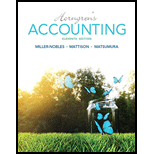
Concept explainers
Concept Introduction:
Equivalent units of Production:
The equivalent units of production can be defined as the units, when they are multiplied with the percentage of their completion, then it is said to be complete units as per their level of completion. For example, in ending inventory, there are 2,000 units 30 % complete, the equivalent units for these 2,000 units will be = 2,000 X 30 % = 600 units. Thus, 600 units are equivalent units.
Requirement 1
To calculate:
a. Beginning inventory % of the materials and % of the conversion costs were added during April, if work-in-process inventory on March 31 was 30 % complete and 45% for conversion costs complete.
b. Ending inventory % of the materials and % of the conversion costs were added during April if work-in-process inventory on April 30 was 65 % complete and 75% for conversion costs complete.
c. Beginning inventory % of the materials and % of the conversion costs were added during April if work-in-process inventory on March 31 was 70 % complete and 80% for conversion costs complete.
d. Ending inventory % of the materials and % of the conversion costs were added during Aprilif work-in-process inventory on April 30 was 55 % complete and 80% for conversion costs complete.
Requirement 2
To compute:
Equivalent units of production for transferred in costs, direct materials, and conversion costs for both the Mixing and the Cooking Departments.
Want to see the full answer?
Check out a sample textbook solution
Chapter 20 Solutions
Horngren's Accounting (11th Edition)
- Can you explain this general accounting question using accurate calculation methods?arrow_forwardPlease provide the solution to this general accounting question with accurate financial calculations.arrow_forwardBrookstone Industries has fixed costs of $715,300. The selling price per unit is $185, and the variable cost per unit is $95. How many units must the company sell in order to earn a profit of $175,000? (Round to Nearest Whole Number)arrow_forward
- I need guidance with this general accounting problem using the right accounting principles.arrow_forwardPlease provide the answer to this general accounting question using the right approach.arrow_forwardPlease explain the solution to this general accounting problem using the correct accounting principles.arrow_forward

 AccountingAccountingISBN:9781337272094Author:WARREN, Carl S., Reeve, James M., Duchac, Jonathan E.Publisher:Cengage Learning,
AccountingAccountingISBN:9781337272094Author:WARREN, Carl S., Reeve, James M., Duchac, Jonathan E.Publisher:Cengage Learning, Accounting Information SystemsAccountingISBN:9781337619202Author:Hall, James A.Publisher:Cengage Learning,
Accounting Information SystemsAccountingISBN:9781337619202Author:Hall, James A.Publisher:Cengage Learning, Horngren's Cost Accounting: A Managerial Emphasis...AccountingISBN:9780134475585Author:Srikant M. Datar, Madhav V. RajanPublisher:PEARSON
Horngren's Cost Accounting: A Managerial Emphasis...AccountingISBN:9780134475585Author:Srikant M. Datar, Madhav V. RajanPublisher:PEARSON Intermediate AccountingAccountingISBN:9781259722660Author:J. David Spiceland, Mark W. Nelson, Wayne M ThomasPublisher:McGraw-Hill Education
Intermediate AccountingAccountingISBN:9781259722660Author:J. David Spiceland, Mark W. Nelson, Wayne M ThomasPublisher:McGraw-Hill Education Financial and Managerial AccountingAccountingISBN:9781259726705Author:John J Wild, Ken W. Shaw, Barbara Chiappetta Fundamental Accounting PrinciplesPublisher:McGraw-Hill Education
Financial and Managerial AccountingAccountingISBN:9781259726705Author:John J Wild, Ken W. Shaw, Barbara Chiappetta Fundamental Accounting PrinciplesPublisher:McGraw-Hill Education





